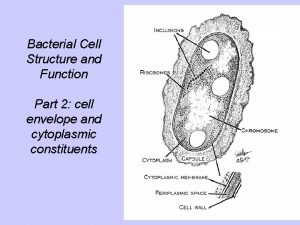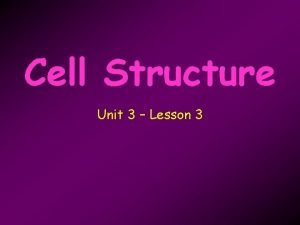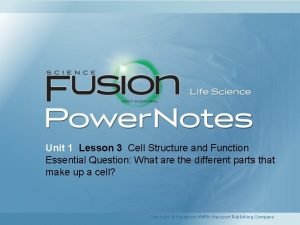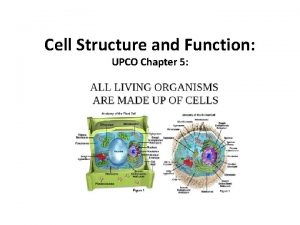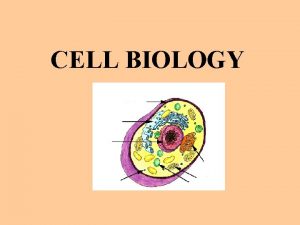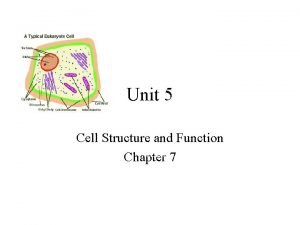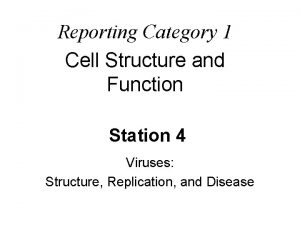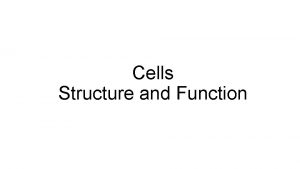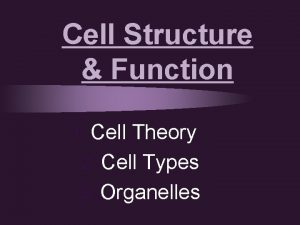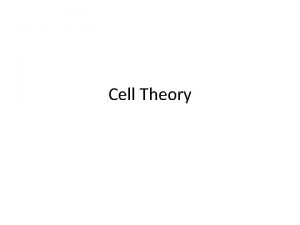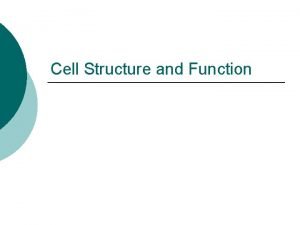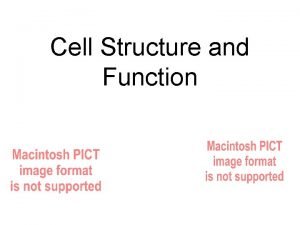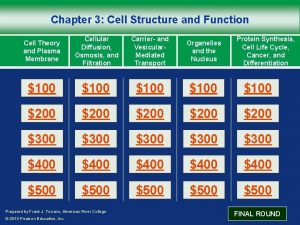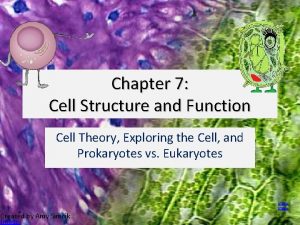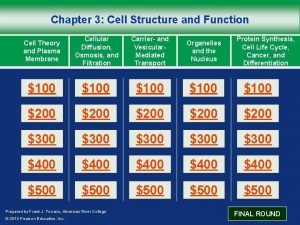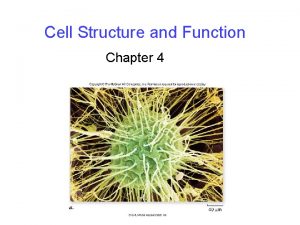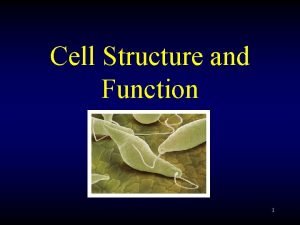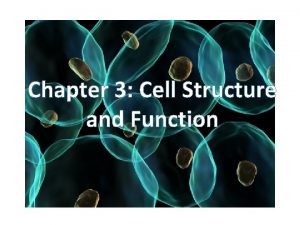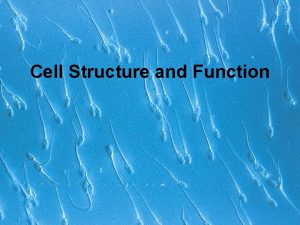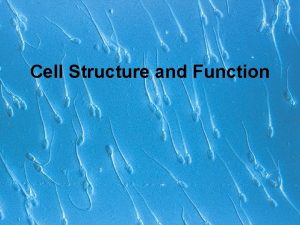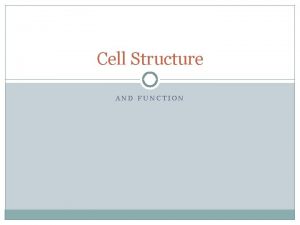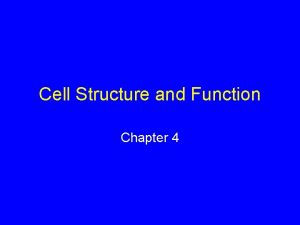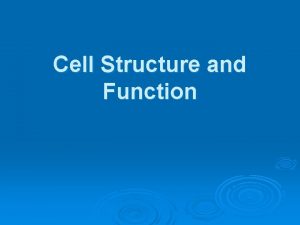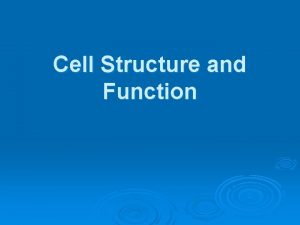Cell Structure and Function 3 1 Cell Theory






























- Slides: 30

Cell Structure and Function

3. 1 Cell Theory TEKS 3 F, 4 A The cell theory grew out of the work of many scientists and improvements in the microscope. • Many scientists contributed to the cell theory. • More was learned about cells as microscopes improved.

3. 1 Cell Theory TEKS 3 F, 4 A The cell theory grew out of the work of many scientists and improvements in the microscope. • Many scientists contributed to the cell theory. • More was learned about cells as microscopes improved. • The cell theory is a unifying concept of biology.

3. 1 Cell Theory TEKS 3 F, 4 A Early studies led to the development of the cell theory. • The Cell theory has three principles. – All organisms are made of cells.

3. 1 Cell Theory TEKS 3 F, 4 A Early studies led to the development of the cell theory. • The Cell theory has three principles. – All organisms are made of cells. – All existing cells are produced by other living cells.

3. 1 Cell Theory TEKS 3 F, 4 A Early studies led to the development of the cell theory. • The Cell theory has three principles. – All organisms are made of cells. – All existing cells are produced by other living cells. – The cell is the most basic unit of life.

Prokaryotes l Genetic material is not in a nucleus l Less complicated and smaller than eukaryotic cell l Example: Bacteria **An organism made of a prokaryotic cell is called a prokaryote.

Prokaryotic Cells

Eukaryotes l Genetic material is contained in a nucleus and separated from the rest of the cell l More complex and larger than prokaryotic cells l Example: Plants, animals, fungi, protists **An organism made of eukaryotic cell(s) is called a eukaryote.

Eukaryotic cells

Eukaryotic cell structure l. Two major parts: ¡Nucleus ¡Cytoplasm-portion of the cell outside the nucleus that contains organelles (parts or “organs” of the cell)

Nucleus-The control center l Structure: ¡ Surrounded by a double membrane called a nuclear envelope. It is dotted with many nuclear pores to allow materials (RNA, proteins, etc) in and out of the nucleus.

Nucleus l Function: ¡Contains almost all of the cell’s DNA for coding proteins and other molecules. ¡DNA is found on chromosomes which contain genetic information. ¡The Control Center of the cell!

Nucleolus l Structure: ¡ Small dense region in the center of the nucleus Function: o where ribosomes are made.

Ribosomes l Structure: ¡ Small pieces of RNA and protein found throughout the cell. ¡ Two subunits. l Function: ¡ Site of protein synthesis.

Rough Endoplasmic Reticulum l Structure: ¡ Membranous system ¡ Rough ER- has ribosomes on surface to assemble proteins ¡ Continuous with the nuclear envelope l Function: ¡ Site where lipid parts of cell membrane are made, along with proteins and other materials to export from the cell.

Smooth Endoplasmic Reticulum l Structure: ¡ Membranous system ¡ NO ribosomes on surface l Function: Synthesis of lipids and phospholipids for membranes Detoxifies drugs and toxins in the cell

Golgi Apparatus l Structure: ¡ Stack of closely packed membranes l Function: ¡ Modify, sort, and package proteins and other materials from the ER for storage in the cell or release from the cell. It puts the finishing touches on proteins.

Lysosomes l Structure: ¡ Small sac, filled with digestive enzymes l Function: ¡ Breakdown of lipids, carbohydrates and proteins into small molecules to be used by the rest of the cell ¡ Breakdown used up organelles ¡ Gets rid of all “stuff” in the cell ¡ The “Clean-up crew”

Vacuole l Structure: ¡ Sac-like ¡ Plant cells have one large central vacuole ¡ Animal cells have many small vacuoles l Function: ¡ Stores water, salts, proteins and carbohydrates

Mitochondria l Structure: ¡ Enclosed by two membranes with the inner folded membrane, called cristae. ¡ Contains it’s own DNA (Evidence for the Endosymbiotic Theory) l Function: ¡ Convert chemical energy in food into materials easier for the cell to use. This is called cell respiration.

Chloroplasts Structure: ¡ Surrounded by two membranes ¡ Stacks of membranes inside called thylakoids. ¡ Contains own genetic information like mitochondria ¡ Contains green pigment called chlorophyll ¡ Not found in animal cells! l Function: ¡ Captures energy from the sun (solar energy) and changes it into food (chemical energy) for plants (photosynthesis).

The History of the cell continued l In 1967, Lynn Margulis proposed that mitochondria and chloroplasts were descended from ancient symbiotic prokaryotes. This theory is called the Endosymbiotic Theory! Click on image to view video

Cytoskeleton- structure and support l Structure: ¡ Two types: microfilaments and microtubules- made of proteins Function: ¡ Helps maintain cell shape ¡ Helps with movement of the cell (i. e. flagella and cilia)

Flagellum l Structure: ¡ long, whip-like structure made of microtubules l Function: ¡ Allows the cell to swim through fluid

Cilia l Structure: ¡ small hair-like structures made of microtubules; beat rhythmically to move fluid outside the cell. l Function: ¡ This propels or anchors the cell.

Centrioles l Structure ¡ Pair of cylindrical arrangement of microtubules found perpendicularly to each other ¡ Region around centrioles called centrosome l Function ¡ help Divide the DNA in ANIMAL CELL division

Cell Membrane l Structure: ¡ Double membrane called a lipid bilayer ¡ Flexible structure that forms a strong barrier between the cell and its surroundings ¡ Phospholipids with integral proteins and cholesterol Function: ¡ Regulates what enters and leaves the cell ¡ Provides protection and support

Cell Wall l Structure: ¡ Lies outside the cell membrane ¡ Made of structural carbohydrates ¡ Found in plants, algae, fungi and many bacteria ¡ NOT FOUND IN ANIMAL CELLS! l Function: ¡ Provides support and protection for the cell

Levels of organization (smallest to largest) 1. Cells 2. Tissues: group of similar cells with specific function ¡ Four types: muscle, epithelial, nervous, connective tissue 3. Organs: groups of tissues working together 4. Organ systems: a group of organs that work together to perform a specific function ¡ Examples: Nervous system, digestive system
 Chapter 4 cell theory and cell study
Chapter 4 cell theory and cell study What is part 2
What is part 2 Lesson 3 cell structure and function answer key
Lesson 3 cell structure and function answer key Organelle graphic organizer
Organelle graphic organizer Plant cell and animal cell
Plant cell and animal cell Cell
Cell Biology chapter 7 cell structure and function
Biology chapter 7 cell structure and function Chapter 7 cell structure and function section review 7-2
Chapter 7 cell structure and function section review 7-2 Cell structure and function graphic organizer
Cell structure and function graphic organizer Chapter 5 cell structure and function
Chapter 5 cell structure and function Cell structure and function
Cell structure and function Unit 5 cell structure and function answer key
Unit 5 cell structure and function answer key Category 1 cell structure and function
Category 1 cell structure and function Category 1 cell structure and function
Category 1 cell structure and function Stages of mitosis in onion root tip
Stages of mitosis in onion root tip Function of the cell wall
Function of the cell wall School community definition
School community definition Difference between mercury cell and diaphragm cell
Difference between mercury cell and diaphragm cell Prokaryotic reproduction
Prokaryotic reproduction Venn diagram plant and animal cell
Venn diagram plant and animal cell Tonoplast
Tonoplast Primary battery and secondary battery
Primary battery and secondary battery Difference between bacteria and plant cell
Difference between bacteria and plant cell Events of the cell cycle
Events of the cell cycle Life
Life Idealized animal cell
Idealized animal cell Walker cell and hadley cell
Walker cell and hadley cell Cell cycle and cell division
Cell cycle and cell division Venn diagram plant vs animal cells
Venn diagram plant vs animal cells Mitosis
Mitosis Galvanic cell and electrolytic cell
Galvanic cell and electrolytic cell

